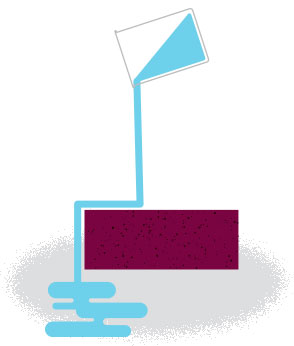Rainwater running off roofs, lawns, streets, and parking lots can wash a variety of water pollutants into lakes and streams.
From Streets to Streams

These pollutants include nutrients from garden fertilizers; bacteria from pet wastes and rotting litter; sediment from erosion; toxic chemicals from pesticides, gasoline, and trace metals from emissions and grinding car parts (lead, mercury, and cadmium); zinc from roofs and gutters; and road salt or sand.
[vc_custom_heading text=”Objectives” font_container=”tag:h4|text_align:left”]
[vc_custom_heading text=”Materials Needed:” font_container=”tag:h4|text_align:left”]
- Define the term runoff.
- Define the terms point and nonpoint source pollution.
- Classify pollution sources as either point or nonpoint source.
- Piece of brick, concrete, or asphalt
- Piece of sod
- Measuring cup
- Tap water
- 3 shallow baking pans
- Trash bags
- Poster board
- Glue
[vc_custom_heading text=”Instructions” font_container=”tag:h4|text_align:left”]
- Place a piece of brick, concrete, or asphalt and pieces of sod into separate shallow pans and set the pans on a table for the students to observe.
- Have students guess what will happen when water is poured on each surface.
- Pour one cup of water on the hard surface and have students describe what is happened, then repeat the procedure on the piece of sod.
- Explain that the excess water that does not soak is called “runoff”.
- Have students relate this experiment to what happens to runoff in a city. Runoff occurs more often in areas where there is concrete, paved roads, or other hard surfaces, and much less in areas covered with vegetation.
- Pet waste is often carried in the runoff, as well as litter, oil, chemicals, and pesticides.
[vc_custom_heading text=”Topics for Discussion” font_container=”tag:h3|text_align:left”]
Discuss how litter contributes to urban water pollution by having the students describe what kinds of litter they frequently see in their community and what happens to it after a heavy rain. Then have students create a plan for their community to reduce the amount of litter in their area.



